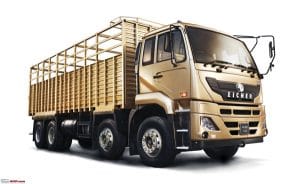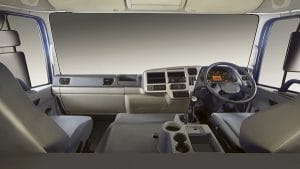
The age of value trucks is here.
Story by Shyam Maller
From the time Chevrolet and Dodge brand of trucks and buses were manufactured under license by manufacturers like Hindustan Motors and Premier Automobiles to the time Volvo and Scania took to making premium trucks, the Indian CV industry has come a long way. It has in the process highlighted the journey of M&HCV segment post rationalisation of the truck axle load norms among others. Well-aligned to the international trucking norms (now starting at 18.5-tonnes GVW), the M&HCV segment has seen significant transformation with the introduction of features like power steering (made mandatory in heavy-duty trucks since 2004) and ABS (made mandatory since 2015) over time. Turning itself into a value-oriented proposition on the basis of technology and safety, the M&HCV segment has attained new heights with the advent of BSVI emission standards especially. From being dominated by two big players (Tata Motors and Ashok Leyland) for decades, and whose market share ratio was roughly to the ratio of either 70:30 or either 68: 32, the M&HCV segment has changed to include more players. This, despite joint ventures (and collaborative efforts) like Hindustan-Isuzu and Simpson-Ford not withstanding. Driven by regulatory changes by the Ministry of Road Transport & Highways (MoRTH) through the Central Motor Vehicle rules 1989 and the Motor Vehicle Act 1988, the M&HCV segment changed quite a bit. It did so in the area of safety and emissions to be more precise.
New Entrants
The BSIII emission norms announced in 2010 had a considerable effect on the M&HCV segment. It was also the starting point of the segment’s evolution. Several regulations followed. The major among them being the BSIV emission standards of April 2017, the new axle norms of 2018 and the BSVI emission standards of April 2020. Metamorphosing the nature of M&HCV segment, these regulations paved the way for new players to enter. Among the first to enter was Eicher Motors Ltd. in 2003 with the 4×2 16.2-tonne GVW (Jumbo) truck, the 6×2 25-tonne GVW (Galaxy) truck, the 8×2 31-tonne GVW truck and the 4×2 40-tonne (Mega) prime mover. Forging a joint venture with MAN Trucks of Germany, Force Motors entered the segment in 2005 with the MAN CLA range of trucks (of 25-tonne to 49-tonne GVW). These trucks soon acquired the reputation of being sturdy workhorses in the multi-axle tipper (8×4 and 6X4) segments, in the prime mover (in the 40 and 49-tonne GVW) range, and in the 4×2 and 6×4 tractor range. They sported a powerful 6.9-litre power plant that developed between 220 hp and 280 hp with class-leading torque values at 800 Nm and 1100 Nm. At the fag end of 2010, Mahindra Navistar Automotives Ltd. entered the M&HCV segment. In 2012, Daimler began serial production of M&HCVs
at Chennai.

If the Mahindra Navistar trucks sported a world-class cabin that was claimed to be the most spacious, Daimler announced that it would sell trucks with factory-built cabin only. Both the brands installed powerful engines in their vehicles. It lead to the underlining of a key defining factor in trucks, transforming their image to ‘value’ trucks. Also, demonstrating that higher engine capacity and power means superior power to weight ratio and superior fuel efficiency. Quite opposite of the notion till then, that higher displacement and power would translate lower fuel efficiency and higher running costs. Change was here to stay it was evident. Technology assumed charge as the industry leapfrogged from BSIV emission norms (effective April 2017) to BSVI emission norms (in April 2020). OEMs rose up to the challenge. The term ‘value trucks’ took on a new meaning. It added a new dimension to the M&HCV segment, giving it an edge never seen before. Including trucks that were contemporary in more ways than one, the M&HCV segment hinted at not just new-age machines, but also at modern plants in which they were manufactured.
Projecting themselves as workhorses meant to deliver superior TCO, the M&HCV value trucks over time have come to reflect greater use of electronics, plastics and new metallurgical structures. Not only are they modern in their appearance, they are also replete with modern features (ably backed by technology of course) like telematics, cruise control, real-time fuel coaching, diagnostics, etc. Powerful, reliable, efficient, comfortable and safe, they are more attuned to the regulatory needs as well as dynamic needs of the market. Better yet, they have been successful in closing the gap between basic trucks and premium trucks. The improvement in aggregates as well as the choice to select them as per the intended application has come to include stronger chassis (of Domex steel), lubricated for life propeller shafts, unitised wheel bearings, and various other design elements that extend the service interval; elevate reliability and reduce warranty claims (in part, extend warranty coverage of up to six-years or 600,000 km for driveline, for example). Value trucks have got OEMs to bet big on telematics as a pro-active way to enhance profitability; to stay connected. The ‘connected’ truck functionalities encompass fuel management, trip management, remote diagnostics and predictive maintenance. It is because of telematics and developments related to it, that the CV manufacturers have succeeded in setting up up-time centres (much like a control tower in an airport) capable of elevating the driver and operator support system to a new level.
Capable of connecting the driver with the dealer with the up-time centre for guidance troubleshooting, technical knowledge, asset utilisation, reduction in operating expenses and to further elevate driver behaviour through virtual as well as real-time coaching, value trucks have come to promise lower TCO and higher profitability like no other. It is not surprising therefore that almost all the CV manufacturers have made telematics a standard fitment on their BSVI trucks. The positioning and differentiation strategy of OEMs pertaining to their value truck offerings as fuel-efficient, safe, comfortable, convenient, reliable and durable machines has been well received. The proposition of better TCO compared to their rivals has been the talking point of it all. With ‘customer and his business success’ at the centre of new developments concerning value trucks, a new age beckons. It is about an opportune moment for OEMs to reboot their strategies, re-imagine the future of Indian trucking and chart a new innovation call. A call that is about an ability to introspect, practice ingenuity and involve all the stakeholders.
…………………………………………………
The author was former executive vice president – sales, marketing and aftermarket at VE Commercial Vehicles Ltd. The views expressed by the author are his personal opinion and do not necessarily reflect the views of the CV magazine.




















